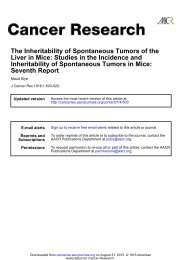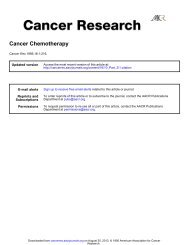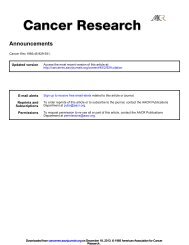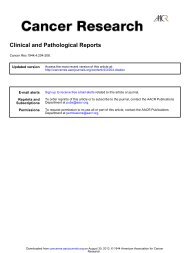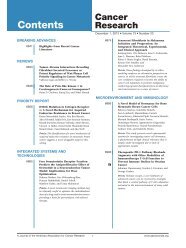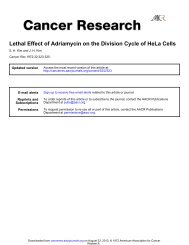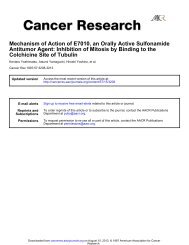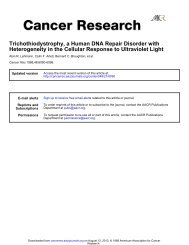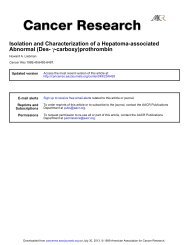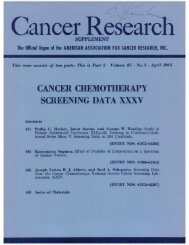Mutations in the p53 Gene in Primary Human ... - Cancer Research
Mutations in the p53 Gene in Primary Human ... - Cancer Research
Mutations in the p53 Gene in Primary Human ... - Cancer Research
You also want an ePaper? Increase the reach of your titles
YUMPU automatically turns print PDFs into web optimized ePapers that Google loves.
<strong>Mutations</strong> <strong>in</strong> <strong>the</strong> <strong>p53</strong> <strong>Gene</strong> <strong>in</strong> <strong>Primary</strong> <strong>Human</strong> Breast <strong>Cancer</strong>s<br />
R. J. Osborne, G. R. Merlo, T. Mitsudomi, et al.<br />
<strong>Cancer</strong> Res 1991;51:6194-6198.<br />
Updated version<br />
Access <strong>the</strong> most recent version of this article at:<br />
http://cancerres.aacrjournals.org/content/51/22/6194<br />
E-mail alerts Sign up to receive free email-alerts related to this article or journal.<br />
Repr<strong>in</strong>ts and<br />
Subscriptions<br />
Permissions<br />
To order repr<strong>in</strong>ts of this article or to subscribe to <strong>the</strong> journal, contact <strong>the</strong> AACR Publications<br />
Department at pubs@aacr.org.<br />
To request permission to re-use all or part of this article, contact <strong>the</strong> AACR Publications<br />
Department at permissions@aacr.org.<br />
Downloaded from<br />
cancerres.aacrjournals.org on July 20, 2013. © 1991 American Association for <strong>Cancer</strong> <strong>Research</strong>.
[CANCER RESEARCH 51.6194-6198. November 15. 19911<br />
Advances <strong>in</strong> Brief<br />
<strong>Mutations</strong> <strong>in</strong> <strong>the</strong> <strong>p53</strong> <strong>Gene</strong> <strong>in</strong> <strong>Primary</strong> <strong>Human</strong> Breast <strong>Cancer</strong>s1<br />
R. J. Osborne,2 G. R. Merlo, T. Mitsudomi, T. Venesio, D. S. Liscia, A. P. M. Cappa, I. Chiba, T. Takahashi,<br />
M. M. Ñau, R. Callahan, and J. D. M<strong>in</strong>na3<br />
.\avy Medical Oncology Branch [R. J. O.. T. M.. I. O, T. T.. M. M. N.. J. D. M.] and Oncogenetics Section /G. R. M.. T. l'.. R. C.J National <strong>Cancer</strong> Institute, Be<strong>the</strong>sda.<br />
Maryland 20X92, and Ospedale S. Giovanni Vecchio. Tur<strong>in</strong>. Italy ¡D.S. L, A. P. M. C.J<br />
Abstract<br />
Twenty-six primary breast tumors were exam<strong>in</strong>ed for mutations <strong>in</strong> <strong>the</strong><br />
<strong>p53</strong> tumor suppressor gene by an KNase protection assay and nucleotide<br />
sequence analysis of PCR-amplified <strong>p53</strong> complementary DNAs. Each<br />
method detected <strong>p53</strong> mutations <strong>in</strong> <strong>the</strong> same three tumors (12%). One<br />
tumor conta<strong>in</strong>ed two mutations <strong>in</strong> <strong>the</strong> same alÃele.S<strong>in</strong>gle strand confor<br />
mation polymorphism analysis of genomic DNA and complementary<br />
DNA proved more sensitive <strong>in</strong> <strong>the</strong> detection of mutations. Comb<strong>in</strong><strong>in</strong>g this<br />
technique with <strong>the</strong> o<strong>the</strong>r two a total of 12 mutations <strong>in</strong> <strong>the</strong> p5i gene were<br />
demonstrated <strong>in</strong> 11 tumors (46%), and a polymorphism at codon 213 was<br />
detected <strong>in</strong> ano<strong>the</strong>r tumor. Loss of heterozygosity on chromosome 17p<br />
was detected by Sou<strong>the</strong>rn blot analysis <strong>in</strong> 30% of <strong>the</strong> tumor DNAs. Not<br />
all of <strong>the</strong> tumors conta<strong>in</strong><strong>in</strong>g a po<strong>in</strong>t mutation <strong>in</strong> <strong>p53</strong> also had loss of<br />
heterozygosity of <strong>the</strong> rema<strong>in</strong><strong>in</strong>g alÃele,suggest<strong>in</strong>g that loss of heterozy<br />
gosity may represent a later event.<br />
Introduction<br />
There is now substantial evidence that genetic abnormalities<br />
affect<strong>in</strong>g <strong>the</strong> <strong>p53</strong> gene are frequently associated with <strong>the</strong> path-<br />
ogenesis of several neoplasias, particularly solid tumors such as<br />
breast, colon, and lung carc<strong>in</strong>omas (1). The mutations appear<br />
to cluster <strong>in</strong> highly conserved regions of <strong>the</strong> gene (2) and <strong>in</strong><br />
some cases appear to <strong>in</strong>activate <strong>the</strong> growth-regulatory functions<br />
of <strong>the</strong> prote<strong>in</strong> (3, 4). This has been taken as evidence that <strong>p53</strong><br />
is a tumor suppressor gene which when mutated, contributes to<br />
<strong>the</strong> malignant progression of <strong>the</strong> tumor. The frequency of <strong>p53</strong><br />
mutations <strong>in</strong> primary breast carc<strong>in</strong>omas has been directly de<br />
term<strong>in</strong>ed <strong>in</strong> only a limited number of cases (5-9). However,<br />
us<strong>in</strong>g immunohistochemical detection of abnormal <strong>p53</strong> prote<strong>in</strong><br />
<strong>in</strong> primary breast tumors (7, 10, 11) it has been <strong>in</strong>ferred that<br />
about 50% of <strong>the</strong> tumors conta<strong>in</strong> a <strong>p53</strong> mutation. Similarly,<br />
exam<strong>in</strong>ation of primary breast tumor DNAs has revealed LOH4<br />
on <strong>the</strong> short arm of chromosome 17, <strong>the</strong> location of <strong>the</strong> <strong>p53</strong><br />
gene, <strong>in</strong> approximately 50% of cases (6, 12-15). In <strong>the</strong> present<br />
study we have undertaken a comprehensive molecular analysis<br />
to directly determ<strong>in</strong>e <strong>the</strong> frequency of genetic abnormalities<br />
affect<strong>in</strong>g <strong>the</strong> <strong>p53</strong> locus <strong>in</strong> 26 primary breast tumors as well as<br />
to determ<strong>in</strong>e how this is related to LOH on chromosome 17p.<br />
Received 9/3/91; accepted 9/27/91.<br />
The costs of publication of this article »eredefrayed <strong>in</strong> part by <strong>the</strong> payment<br />
of page charges. This article must <strong>the</strong>refore be hereby marked advertisement <strong>in</strong><br />
accordance with 18 U.S.C. Section 1734 solely to <strong>in</strong>dicate this fact.<br />
1This work was supported <strong>in</strong> part by a grant from <strong>the</strong> Associazione Italiana<br />
Ricerca sul Cancro.<br />
2Present address: Department of Cl<strong>in</strong>ical Oncology. Addenbrookes's Hospital.<br />
Cambridge. CB2 2QQ, England.<br />
3To whom requests for repr<strong>in</strong>ts should be addressed, at Simmons <strong>Cancer</strong><br />
Center. University of Texas Southwestern Medical Center. 5323 Harry Hiñes<br />
Blvd.. Dallas. TX 75235-8590.<br />
4The abbreviations used are : LOH. loss of hctero/ygosity; RFLP. restriction<br />
fragment length polymorphism: cDNA. complementary DNA; PC'R. polymerase<br />
cha<strong>in</strong> reaction; SSCP. s<strong>in</strong>gle strand conformation polymorphism; ORF. open<br />
read<strong>in</strong>g frame.<br />
Materials and Methods<br />
Sample Acquisition and Preparation. Infiltrat<strong>in</strong>g ductal carc<strong>in</strong>omas<br />
were obta<strong>in</strong>ed from 27 patients at <strong>the</strong> S. Giovanni Vecchio Hospital<br />
(Tur<strong>in</strong>, Italy) who had not undergone treatment prior to surgery.<br />
Macroscopically normal mammary tissue was manually removed, and<br />
<strong>the</strong> tumor tissue was quickly frozen and embedded <strong>in</strong> OCT compound<br />
(Miles Scientific, Kankakee, IL) for <strong>in</strong>traoperative diagnosis. Areas of<br />
<strong>the</strong> specimen with a predom<strong>in</strong>ant neoplastic component were collected<br />
and stored at —¿70°C for fur<strong>the</strong>r analysis. Lymphocytes from <strong>the</strong> same<br />
patients were isolated from 20 ml hepar<strong>in</strong>ized blood by density gradient<br />
centrifugation on LSM Ficoll medium (Organon Teknica Co.. Durham,<br />
NC) accord<strong>in</strong>g to <strong>the</strong> manufacturer's <strong>in</strong>structions.<br />
DNA and RNA Preparation. High-molecular-weight DNA was pre<br />
pared from frozen tissues and lymphocytes as described (15). After<br />
ethanol precipitation, <strong>the</strong> DNA samples were dissolved <strong>in</strong> IO mM Tris/<br />
1 mM EDTA (pH 7.4) and stored at -20°C. Total RNA was extracted<br />
as described (16), redissolved <strong>in</strong> 10 mM Tris buffer. pH 7.5, and stored<br />
precipitated at —¿70°C.<br />
DNA Probes and Analysis of Genomic DNA and RNA. The follow<strong>in</strong>g<br />
probes were used: pYNZ22.1 (chromosome 17pl3.3, D17S5, ATCC<br />
57575; Ref. 17) was obta<strong>in</strong>ed from <strong>the</strong> American Type Culture Collec<br />
tion (Rockville, MD) and identifies a variable number tandem repeat<br />
RFLP <strong>in</strong> BamHl- and Piil-digested human genomic DNA; and<br />
pBHP53 (18), a genomic <strong>p53</strong> fragment, identifies a BamHl RFLP<br />
with<strong>in</strong> <strong>the</strong> <strong>p53</strong> gene. The <strong>p53</strong> locus was analyzed by two <strong>in</strong>dependent<br />
methods: (a) Sou<strong>the</strong>rn blot analysis us<strong>in</strong>g <strong>the</strong> pBHP53 DNA probe and<br />
(h) PCR-based amplification of a 250-base pair genomic fragment<br />
conta<strong>in</strong><strong>in</strong>g <strong>the</strong> Tha\ RFLP at codon 72, as described (19). The DNA<br />
probes were labeled with [
cDNA/PCR/Clon<strong>in</strong>g/Sequenc<strong>in</strong>g. First-strand cDNAs were syn<strong>the</strong><br />
sized from 20 Mgof total cellular RNA us<strong>in</strong>g random primers (Phar<br />
macia, Piscataway, NJ). Subsequent PCR amplification of <strong>the</strong> products<br />
was performed us<strong>in</strong>g /755-specific oligonucleotide primers located<br />
just outside <strong>the</strong> ORF, as described (20), except that <strong>the</strong> primers con<br />
ta<strong>in</strong>ed a H<strong>in</strong>d\\\ or Xbal site at <strong>the</strong>ir 5' and 3' ends, respectively. The<br />
primers used were: sense, 5'-AGTCAAGCTTGACGGTGA-<br />
CACGCTTCCCTGGATT-3', and antisense, 5'-AGTCTCTAGAT-<br />
CAGTGGGGAAGAAGAAGTGGAGA-3'. The PCR products were<br />
cloned <strong>in</strong>to <strong>the</strong> H<strong>in</strong>dlll-Xbal sites of <strong>the</strong> plasmid pRC/CMV (Invitrogen,<br />
San Diego, CA). Plamid DNAs were prepared from pooled clones<br />
us<strong>in</strong>g <strong>the</strong> M<strong>in</strong>iprep Kit Plus (Pharmacia) and sequenced us<strong>in</strong>g <strong>p53</strong><br />
ORF-specific primers and <strong>the</strong> Sequenase II kit (USB) with [35S]dATP<br />
(Amersham).<br />
Results<br />
<strong>p53</strong> MUTATIONS IN BREAST CANCER<br />
Detection of <strong>Mutations</strong> <strong>in</strong> <strong>p53</strong> Genomic DNA, RNA, and<br />
cDNA. RNase protection assays were performed on total RNA<br />
samples from tumors us<strong>in</strong>g probes spann<strong>in</strong>g <strong>the</strong> entire <strong>p53</strong><br />
ORF. An abnormal pattern of protected RNA species was<br />
observed <strong>in</strong> tumors 32, 39, and 87 (Table 1). These patterns<br />
suggested that <strong>the</strong> mutations map with<strong>in</strong> <strong>the</strong> <strong>p53</strong> ORF (20). To<br />
confirm and extend <strong>the</strong>se results <strong>the</strong> nucleotide sequence of <strong>the</strong><br />
<strong>p53</strong> ORF was determ<strong>in</strong>ed on pools of PCR-amplified <strong>p53</strong><br />
cDNA clones for each of <strong>the</strong> 26 tumors (Table 1). This analysis<br />
showed that tumor 32 had two po<strong>in</strong>t mutations (codon 280<br />
AGA -»ACA, arg —¿ thr; codon 285 GAG -»AAG, glu -»lys).<br />
Fur<strong>the</strong>r sequence analysis of <strong>in</strong>dividual <strong>p53</strong> clones showed that<br />
both mutations were present <strong>in</strong> <strong>the</strong> same alÃele(data not shown).<br />
Two o<strong>the</strong>r tumors each conta<strong>in</strong>ed<br />
conta<strong>in</strong>ed a s<strong>in</strong>gle po<strong>in</strong>t mutation<br />
a s<strong>in</strong>gle mutation. Tumor 39<br />
at codon 238 (TGT —¿> TTT,<br />
cys —¿Â» phe), while tumor 87 conta<strong>in</strong>ed a deletion encompass<strong>in</strong>g<br />
exon 4 (codons 33 to 126). This latter abnormality probably<br />
arose as a mRNA splic<strong>in</strong>g error result<strong>in</strong>g from an <strong>in</strong>tronic<br />
mutation similar to one described <strong>in</strong> a case of small cell lung<br />
cancer (23). The mutations detected <strong>in</strong> <strong>the</strong>se three tumors by<br />
nucleotide sequence analysis corresponded exactly to <strong>the</strong> loca<br />
tion of <strong>the</strong> abnormalities <strong>in</strong>dicated by RNase protection assay.<br />
Moreover, <strong>the</strong>re was no evidence for <strong>the</strong> expression of a normal<br />
sequence coexist<strong>in</strong>g with <strong>the</strong> mutant <strong>p53</strong> sequence.<br />
We were concerned about <strong>the</strong> apparent low frequency (12%)<br />
of mutations <strong>in</strong> <strong>the</strong> <strong>p53</strong> gene relative to <strong>the</strong> published higher<br />
frequencies of LOH <strong>in</strong> this region of chromosome 17p (50%)<br />
and immunohistochemical sta<strong>in</strong><strong>in</strong>g of <strong>p53</strong> prote<strong>in</strong> <strong>in</strong> tumor<br />
sections (50%). It seemed possible that some mutations could<br />
have been missed due to <strong>the</strong> presence of contam<strong>in</strong>at<strong>in</strong>g normal<br />
stromal tissue or a heterogeneity of tumor cells conta<strong>in</strong><strong>in</strong>g <strong>the</strong><br />
mutation <strong>in</strong> <strong>the</strong> tumor biopsy material. To address this possi<br />
bility we surveyed 24 of <strong>the</strong> tumor DNAs and RNAs us<strong>in</strong>g <strong>the</strong><br />
SSCP assay (21). SSCP assays were performed on PCR-ampli<br />
fied DNA fragments us<strong>in</strong>g tumor-derived genomic DNA (cov<br />
er<strong>in</strong>g exons 5 through 8, am<strong>in</strong>o acids 126-306) and cDNA<br />
(cover<strong>in</strong>g exons 4 through 9, codons 33-331) as templates.<br />
<strong>Gene</strong>tic abnormalities were observed <strong>in</strong> genomic DNA samples<br />
from ten tumors (tumors 28, 32, 37, 53, 66, 75, 77, 80, 81, and<br />
85; Fig. 1 and Table 1). However, <strong>in</strong> tumor 28 <strong>the</strong> alteration<br />
mapped to codon 213 which we have recently found represents<br />
a naturally occurr<strong>in</strong>g polymorphism. In tumor 87 <strong>the</strong> <strong>p53</strong><br />
mutation detected by RNase protection assays and cDNA se<br />
quenc<strong>in</strong>g was a deletion of exon 4, an area not covered <strong>in</strong> <strong>the</strong><br />
genomic SSCP assay. Thus a total of 11 of <strong>the</strong> 24 tumors (46%)<br />
had a mutation(s) <strong>in</strong> <strong>the</strong> <strong>p53</strong> gene. SSCP analysis of cDNA<br />
confirmed a majority of <strong>the</strong> mutations found <strong>in</strong> genomic DNA<br />
(Fig. 2).<br />
RFLP Analysis of <strong>the</strong> <strong>p53</strong> and pYNZ22.1 Loci. To determ<strong>in</strong>e<br />
whe<strong>the</strong>r LOH on chromosome 17p correlates with mutation <strong>in</strong><br />
<strong>the</strong> <strong>p53</strong> gene, genomic DNA samples from <strong>the</strong> breast tumor<br />
DNAs were compared to <strong>the</strong> constitutional (lymphocyte) gen<br />
omic DNAs from <strong>the</strong> same patients for LOH at <strong>the</strong> <strong>p53</strong> and<br />
pYNZ22.1 loci (Fig. 3 and Table 1). N<strong>in</strong>eteen of 26 patients<br />
(73%) were constitutionally heterozygous for <strong>p53</strong> (analyzed by<br />
pBHP53, BamHl RFLP and/or codon 72 RFLP), while six<br />
(30%) had LOH at <strong>the</strong> <strong>p53</strong> gene. Five of <strong>the</strong>se six tumors also<br />
had a mutation(s) <strong>in</strong> <strong>the</strong> rema<strong>in</strong><strong>in</strong>g <strong>p53</strong> alÃele(Table 1). How-<br />
Table 1 Status of<strong>the</strong><strong>p53</strong> gene <strong>in</strong> primary human breast tumors us<strong>in</strong>g various molecular techniques<br />
clone<br />
SSCP exons exons7/8Not<br />
Tumor71327313536414548586578828628123739536675778081858717pl3.3<br />
pYNZ22.1HeterozygousHeterozygousHeterozygousDeletedNon<br />
<strong>p53</strong>HeterozygousHeterozygousNon protectionNormalNormalNormalNormalNormalNormalNormalNormalNormalNormalNormalNormalNormalNormalNormalAbn<br />
sequenceNormalNormalNormalNormalNormalNormalNormalNormalNormalNormalNormalNormalNorma<br />
mutation" 5/6Not<br />
<strong>in</strong>f.HeterozygousNon<br />
<strong>in</strong>f.HeterozygousNon<br />
<strong>in</strong>f.Non<br />
<strong>in</strong>f.HeterozygousHeterozygousNon <strong>in</strong>f.Non<br />
testedNormalNormalNormalNormalNormalNormalCodon<br />
testedNormalNormalNormalNormalNo<br />
<strong>in</strong>f.HeterozygousHeterozygousHeterozygousHeterozygousHeterozygousHeterozygousDeletedNot<br />
<strong>in</strong>f.Non<br />
<strong>in</strong>f.HeterozygousDeletedHeterozygousHeterozygousHeterozygousDeletedHeterozygousHeterozygousNon<br />
<strong>in</strong>f.DeletedNon<br />
<strong>in</strong>f."DeletedHeterozygousNon<br />
testedDeletedNon<br />
<strong>in</strong>f.HeterozygousNon<br />
<strong>in</strong>f.HeterozygousDeletedDeleted17pl3.1<br />
<strong>in</strong>f.DeletedHeterozygousHeterozygousDeletedDeletedRNase<br />
•¿ Number <strong>in</strong>dicates codon position.<br />
* Non <strong>in</strong>f.. non-<strong>in</strong>formative at <strong>the</strong> particular locus: del., deletion: pol., polymorphism.<br />
6195<br />
pol.*280<br />
NormalNormal238<br />
& 285<br />
testedNormalNormalNormalNormalNormalNormalNot<br />
testedNormalNormalNormalNormalNo<br />
213<br />
NormalMut.<br />
5Mut. exon<br />
5NormalMut. exon<br />
5NormalMut. exon<br />
5Mut. exon<br />
6Del.<br />
33-126*<br />
exon<br />
NormalSSCP<br />
8Mut. exon<br />
7Not exon<br />
testedNormalNormalMut.<br />
8NormalMut. exon<br />
Downloaded from<br />
cancerres.aacrjournals.org on July 20, 2013. © 1991 American Association for <strong>Cancer</strong> <strong>Research</strong>.<br />
7NormalNormalNormal<br />
exon
1.<br />
Fig. 1. SSCP analysis of PCR-amplified/?5.J DNA from primary human breast<br />
tumor DNAs. The primers and conditions of <strong>the</strong> PCR are given <strong>in</strong> "Materials<br />
and Methods." The PCR products were digested with ei<strong>the</strong>r,-fad (exons 5/6) or<br />
oral (exons 7/8) and <strong>the</strong>n electrophoretically separated on a 6% nondenatur<strong>in</strong>g<br />
acrylamide gel. Brackets, alÃelesfor exons 5/6 and exons 7/8. The numbers above<br />
each lane correspond to specific breast tumors DNAs. Arrows, novel or mutant<br />
alÃeles.<br />
ever, three of <strong>the</strong> tumors hav<strong>in</strong>g a <strong>p53</strong> mutation reta<strong>in</strong>ed<br />
heterozygosity at <strong>the</strong> <strong>p53</strong> locus (tumors 66, 80, and 81). At <strong>the</strong><br />
pYNZ22.1 locus 19 of 25 patients tested were constitutionally<br />
heterozygous. Six (32%) of <strong>the</strong> <strong>in</strong>formative patients showed a<br />
LOH <strong>in</strong> <strong>the</strong> tumor DNA. Four of <strong>the</strong>se had mutations <strong>in</strong> <strong>p53</strong><br />
while two, 31 and 81, did not (Table 1). In tumor 31, <strong>the</strong>re are<br />
several possible explanations for <strong>the</strong> apparent absence of a <strong>p53</strong><br />
mutation <strong>in</strong> <strong>the</strong> rema<strong>in</strong><strong>in</strong>g alÃele:(a) a mutation occurred <strong>in</strong> a<br />
region of<strong>p53</strong> not covered by our analysis; (b) LOH has preceded<br />
<strong>the</strong> development of a mutation <strong>in</strong> <strong>the</strong> rema<strong>in</strong><strong>in</strong>g <strong>p53</strong> alÃele;(c)<br />
<strong>the</strong> rema<strong>in</strong><strong>in</strong>g <strong>p53</strong> alÃele<strong>in</strong> <strong>the</strong> tumor was transcriptionally<br />
silent and <strong>the</strong> cDNA was generated almost exclusively from<br />
RNA from normal cells <strong>in</strong> <strong>the</strong> tumor specimen; and (d) ano<strong>the</strong>r<br />
unknown tumor suppressor gene, closely l<strong>in</strong>ked to <strong>p53</strong>, is<br />
altered. Consistent with <strong>the</strong> latter possibility tumor 86 showed<br />
LOH for pYNZ22.1 while reta<strong>in</strong><strong>in</strong>g two normal <strong>p53</strong> alÃeles.<br />
Discussion<br />
A variety of genetic alterations have previously been observed<br />
<strong>in</strong> <strong>the</strong> <strong>p53</strong> gene <strong>in</strong> various malignant tissues (reviewed <strong>in</strong> Ref.<br />
1). In general, <strong>the</strong>se abnormalities appear to abrogate <strong>the</strong> nor<br />
mal function of <strong>the</strong> gene product as well as prolong its half-life<br />
<strong>in</strong> <strong>the</strong> cell. It is thought that <strong>the</strong> prolonged half-life of <strong>the</strong><br />
altered prote<strong>in</strong> is primarily responsible for its detection <strong>in</strong> 50%<br />
of primary human breast tumors by immunohistochemical tech<br />
niques. In our study, 11 of 24 (46%) primary breast carc<strong>in</strong>omas<br />
conta<strong>in</strong>ed mutations <strong>in</strong> <strong>the</strong> <strong>p53</strong> gene. Although this frequency<br />
of mutations is similar to that <strong>in</strong>ferred from immunohistochem<br />
ical techniques, it is clearly dependent on <strong>the</strong> methodology used<br />
to detect <strong>the</strong> mutation. Thus, <strong>in</strong> our tumor panel only three of<br />
<strong>the</strong> eleven mutations detected by SSCP analysis were detected<br />
p5ìMUTATIONS IN BREAST CANCER<br />
6196<br />
by RNase protection assays or nucleotide sequence analysis of<br />
<strong>the</strong> PCR product of <strong>p53</strong> cDNA. We believe this reflects <strong>the</strong><br />
variable contam<strong>in</strong>ation of <strong>the</strong> tumor biopsy material with nor<br />
mal stroma tissue as well as <strong>the</strong> probable heterogeneity of tumor<br />
cells which conta<strong>in</strong> <strong>the</strong> mutation with<strong>in</strong> some biopsies. In<br />
addition, <strong>the</strong> published rate of detection of mutations by <strong>the</strong><br />
00 CM CO LO<br />
LO T-<br />
CNICO LOGO CMCO CO r^ oo<br />
t*<br />
•¿ -<br />
•¿<br />
4-7<br />
7-9<br />
Fig. 2. SSCP analysis of PCR-amplified DNA from primary breast tumorderived<br />
<strong>p53</strong> cDNA. The conditions for cDNA syn<strong>the</strong>sis and PCR amplification<br />
are given <strong>in</strong> "Materials and Methods." The PCR products were digested with<br />
,-i/M'NI and <strong>the</strong>n separated on a 6rr nondenatur<strong>in</strong>g acrylamide gel. brackets.<br />
alÃelesfor exons 4-7 and exons 7-9. The numbers above each lane correspond to<br />
specific breast tumors. Arrows, novel or mutant alÃeles.<br />
Downloaded from<br />
cancerres.aacrjournals.org on July 20, 2013. © 1991 American Association for <strong>Cancer</strong> <strong>Research</strong>.
Fig. 3. <strong>Gene</strong>tic abnormalities for markers<br />
on chromosome 17p <strong>in</strong> human breast cancer.<br />
The locus pYNZ22.1 (A) was analyzed by con<br />
ventional Sou<strong>the</strong>rn hybridization. Tumor<br />
DNAs 31. 39. and 77 represent examples of a<br />
LOH at <strong>the</strong> pYNZ22.1 locus. The pSJ locus<br />
(B) was analyzed by a novel PCR-based tech<br />
nique ( 19). Examples of LOH at <strong>the</strong> <strong>p53</strong> locus<br />
are tumor DNAs 32 and 87. while <strong>in</strong> tumor<br />
DNAs 86 and 66 <strong>the</strong>re is a normal amount of<br />
each alÃele.L and T. lymphocyte and tumor<br />
DNA samples, respectively, from <strong>the</strong> same<br />
patient.<br />
RNase protection assay is only 50% (20).<br />
The site of <strong>the</strong> mutations observed may have important<br />
consequences for <strong>the</strong> biological activity of <strong>the</strong> prote<strong>in</strong> (3, 4).<br />
For <strong>in</strong>stance, three of <strong>the</strong> four mutations detected <strong>in</strong> <strong>the</strong> present<br />
study have previously been observed <strong>in</strong> o<strong>the</strong>r tumors. The<br />
deletion <strong>in</strong> tumor 87 was identical to that occurr<strong>in</strong>g <strong>in</strong> a lung<br />
tumor cell l<strong>in</strong>e (20). The po<strong>in</strong>t mutation at codon 285 <strong>in</strong> sample<br />
32 has been observed <strong>in</strong> a breast cancer cell l<strong>in</strong>e, and codon 280<br />
was also <strong>the</strong> site of mutation (nonidentical) <strong>in</strong> ano<strong>the</strong>r breast<br />
cancer cell l<strong>in</strong>e (8). Of <strong>the</strong> 12 mutations detected <strong>in</strong> this study,<br />
one occurred <strong>in</strong> exon 4, four <strong>in</strong> exon 5, one <strong>in</strong> exon 6, and two<br />
<strong>in</strong> each of exons 7 and 8. Although <strong>in</strong> our panel exon 5 is<br />
affected most frequently by mutation, when our data is added<br />
to <strong>the</strong> published work (1, 5-9, 14) <strong>the</strong>re does not appear to be<br />
a preferential selection for mutations occurr<strong>in</strong>g <strong>in</strong> one con<br />
served doma<strong>in</strong> over ano<strong>the</strong>r <strong>in</strong> primary human breast tumors.<br />
Inactivation of a tumor suppressor gene requires two <strong>in</strong>de<br />
pendent mutagenic events (reviewed <strong>in</strong> Ref. 24). LOH on chro<br />
mosome 17p has been frequently detected <strong>in</strong> sporadic primary<br />
human breast carc<strong>in</strong>omas (6, 12-15). However, with respect to<br />
<strong>the</strong> <strong>in</strong>activation of<strong>p53</strong> <strong>the</strong>re is little <strong>in</strong>formation available as to<br />
whe<strong>the</strong>r <strong>in</strong> sporadic breast cancer <strong>the</strong>re is a preferred order of<br />
mutagenic events dur<strong>in</strong>g tumor progression. In our study, <strong>the</strong>re<br />
were n<strong>in</strong>e breast tumors from patients which were <strong>in</strong>formative<br />
for <strong>the</strong> genomic <strong>p53</strong> restriction site polymorphisms and con<br />
ta<strong>in</strong>ed po<strong>in</strong>t mutations <strong>in</strong> <strong>p53</strong>. Three of <strong>the</strong> tumors (tumors 66,<br />
80, and 81) had not lost <strong>the</strong> rema<strong>in</strong><strong>in</strong>g normal alÃele,whereas<br />
<strong>the</strong> o<strong>the</strong>rs had LOH at <strong>p53</strong>. This suggests that <strong>the</strong> clonal<br />
outgrowth of cells conta<strong>in</strong><strong>in</strong>g a po<strong>in</strong>t mutation <strong>in</strong> <strong>p53</strong> precedes<br />
LOH <strong>in</strong> this region of chromosome 17 dur<strong>in</strong>g tumor progres<br />
sion. An extreme example of this hypo<strong>the</strong>sis occurs <strong>in</strong> <strong>the</strong> Li-<br />
Fraumeni hereditary cancer syndrome, <strong>in</strong> which breast cancer<br />
is a major component (25). In one affected patient with an<br />
osteosarcoma, <strong>the</strong>re was a somatic LOH of <strong>the</strong> rema<strong>in</strong><strong>in</strong>g <strong>p53</strong><br />
alÃele.One possible exception <strong>in</strong> our study to this scenario was<br />
tumor 31, <strong>in</strong> which LOH occurred at <strong>the</strong> <strong>p53</strong> and YNZ22.1<br />
loci but <strong>the</strong> rema<strong>in</strong><strong>in</strong>g <strong>p53</strong> alÃelewas normal. However, <strong>the</strong>re<br />
may be ano<strong>the</strong>r explanation for this tumor as well as tumor 86,<br />
<strong>in</strong> which both <strong>p53</strong> alÃeleswere normal but LOH had occurred<br />
at YNZ22.1. These tumors may also conta<strong>in</strong> an <strong>in</strong>dependent<br />
A.<br />
mutation <strong>in</strong> ano<strong>the</strong>r tumor suppressor gene which has been<br />
<strong>p53</strong> MUTATIONS IN BREAST CANCER<br />
77<br />
T L<br />
«fr<br />
B.<br />
87 86 32 66<br />
L T T T T L<br />
postulated to be located on chromosome 17p, telomeric to <strong>p53</strong><br />
(26, 27). Fur<strong>the</strong>r studies are required to dissect <strong>the</strong> genetic<br />
lesions on chromosome 17p and document <strong>the</strong> stage of tumor<br />
progression at which <strong>p53</strong> po<strong>in</strong>t mutations and LOH beg<strong>in</strong> to<br />
appear.<br />
Taken toge<strong>the</strong>r, our data show that <strong>the</strong> SSCP technique<br />
represents a highly sensitive approach to determ<strong>in</strong><strong>in</strong>g <strong>the</strong> fre<br />
quency and relative location of/753 mutations <strong>in</strong> primary human<br />
breast tumors. This is important s<strong>in</strong>ce frozen biopsy materials<br />
are frequently contam<strong>in</strong>ated with normal cells of different<br />
orig<strong>in</strong>s which can mask <strong>the</strong> presence of mutations detected<br />
through o<strong>the</strong>r molecular approaches. Us<strong>in</strong>g SSCP it should be<br />
possible to rapidly screen larger panels of primary breast tumor<br />
biopsy material to determ<strong>in</strong>e <strong>the</strong> various cl<strong>in</strong>ical parameters<br />
with which it is associated, <strong>in</strong>clud<strong>in</strong>g patient prognosis. In this<br />
regard it is pert<strong>in</strong>ent that we (26) have found that LOH on<br />
chromosome 17p has a significant association with tumors<br />
hav<strong>in</strong>g a high proliferative <strong>in</strong>dex.<br />
Acknowledgments<br />
The pBHP53 probe was a generous gift of Dr. Y. Nakamura.<br />
References<br />
1. Hollste<strong>in</strong>, M., Sidransky, D., Vogelste<strong>in</strong>. B., and Harris, C. C. <strong>p53</strong> mutations<br />
<strong>in</strong> human cancers. Science (Wash<strong>in</strong>gton DC). 253: 49-53, 1991.<br />
2. Soussi. T.. Carón de Fromental. C., and May, P. Structural aspects of <strong>the</strong><br />
<strong>p53</strong> prote<strong>in</strong> <strong>in</strong> relation to gene evolution. Oncogene, 5: 945-952, 1990.<br />
3. Halevy. H.. Michalovitz, D., and Oren, M. Different tumor-derived <strong>p53</strong><br />
mutants exhibit dist<strong>in</strong>ct biological activities. Science (Wash<strong>in</strong>gton DC), 250:<br />
113-116. 1990.<br />
4. Kern, S. E.. K<strong>in</strong>zler, K. W.. Baker, S. J., Nigro, J. M., Rotter, V., Lev<strong>in</strong>e, A.<br />
J., Friedman, P., Prives. C., and Vogelste<strong>in</strong>, B. Mutant <strong>p53</strong> prote<strong>in</strong>s b<strong>in</strong>d<br />
DNA abnormally <strong>in</strong> vitro. Oncogene. 6: 131-136, 1991.<br />
5. Prosser, J., Thompson. A. M.. Cranston, G., and Evans, H. J. Evidence that<br />
<strong>p53</strong> behaves as a tumour suppressor gene <strong>in</strong> sporadic breast tumours. On<br />
cogene, 5: 1573-1579, 1990.<br />
6. Nigro, J.. Baker. S.. Preis<strong>in</strong>ger. A., Jessup. J. M., Hostetter, R., Cleary, K.,<br />
Bigner, S., Davidson, N., Bayl<strong>in</strong>, S., Devilee, P., Glover, T., Coll<strong>in</strong>s, F.,<br />
Weston, A.. Modali, R., Harris. C., and Vogelste<strong>in</strong>, B. <strong>Mutations</strong> <strong>in</strong> Ihe <strong>p53</strong><br />
gene occur <strong>in</strong> diverse human tumour types. Nature (Lond.). 142: 705-708<br />
1989.<br />
7. Varley, J. M.. Brammar, W. J., Lane, D. P., Swallow, J. E., Dolan, C., and<br />
Walker, R. Loss of chromosome 17pl3 sequences and mutation of <strong>p53</strong> <strong>in</strong><br />
human breast carc<strong>in</strong>omas. Oncogene, 6: 413-421, 1991.<br />
8. Bartek. J., Iggo, R., Gannon, J.. and Lane, D. P. <strong>Gene</strong>tic and immunochem-<br />
6197<br />
Downloaded from<br />
cancerres.aacrjournals.org on July 20, 2013. © 1991 American Association for <strong>Cancer</strong> <strong>Research</strong>.
<strong>p53</strong> MUTATIONS IN BREAST CANCER<br />
ical analysis of mutant <strong>p53</strong> <strong>in</strong> human breast cancer cell l<strong>in</strong>es. Oncogene, 5.-<br />
893-899, 1990.<br />
9. Davidoff. A. M., Kerns, B-J. M., Iglehart, J. D., and Marks, J. R. Ma<strong>in</strong>te<br />
nance of <strong>p53</strong> alterations throughout breast cancer progression. <strong>Cancer</strong> Res.,<br />
51: 2605-2610, 1991.<br />
10. Cattoretti, G., Rilke, F.. Andreola. S., D'Amato. L., and Delia. D. <strong>p53</strong><br />
expression <strong>in</strong> breast cancer. Int. J. <strong>Cancer</strong>, 41: 178-183, 1988.<br />
11. Bartek, J., Bartkova, J., Vojtesek, B., Staskova, Z.. Rejthar, A., Kovarik, J.,<br />
and Lane, D. P. Patterns of expression of <strong>the</strong> <strong>p53</strong> tumour suppressor <strong>in</strong><br />
human breast tissues and tumours <strong>in</strong> situ and <strong>in</strong> vitro. Int. J. <strong>Cancer</strong>, 46:<br />
839-844. 1990.<br />
12. Mackay, J., Steel, C. M., Elder, P. A., Forrest, A. P., and Evans, H. J. AlÃele<br />
loss on short arm of chromosome 17 <strong>in</strong> breast cancers. Lancet, 2: 1384-<br />
1385. 1988.<br />
13. Devilee, P., van den Broek, M., Kuipers-Dijkshoorn. N., Kolluri. R., Meera<br />
Khan, P., Pearson, P., and Cornelisse, C. At least four different chromosomal<br />
regions are <strong>in</strong>volved <strong>in</strong> loss of heterozygosity <strong>in</strong> human breast carc<strong>in</strong>oma.<br />
Genomics. 5: 554-560, 1989.<br />
14. Thompson. A. M., Steel, C. M.. Chetty, U., Hawk<strong>in</strong>s, R. A.. Miller, W. R..<br />
Carter. D. C., Forrest, A. P., and Evans, H. J. <strong>p53</strong> gene mRNA expression<br />
and chromosome 17p alÃeleloss <strong>in</strong> breast cancer. Br. J. <strong>Cancer</strong>, 61: 74-78.<br />
1990.<br />
15. Cropp, C. S., Lidereau, R., Campbell, G., Champene, M. H.. and Callahan,<br />
R. Loss of heterozygosity on chromosome 17 and 18 <strong>in</strong> breast carc<strong>in</strong>oma:<br />
two additional regions identified. Proc. Nati. Acad. Sci. USA. 87: 7737-<br />
7741. 1990.<br />
16. Chomzynsky, P., and Sacci, N. S<strong>in</strong>gle-step method of RNA isolation by acid<br />
guanid<strong>in</strong>ium thiocyanate-phenol-chlorophorm extraction. Anal. Biochem..<br />
162: 156-159, 1987.<br />
17. Nakamura, Y., Ballard. L.. Leppert, M.. O'Connel, P., Lathrop. G. M.,<br />
Lalouel, J., and White, R. Isolation and mapp<strong>in</strong>g of a polymorphic DNA<br />
sequence (pYNZ22) on chromosome 17p (D17S30). Nucleic Acids Res., 16:<br />
5707, 1988.<br />
6198<br />
18. Hoyheim, B., Nakamura, Y., and White, R. A BamH\ polymorphism is<br />
detected by a genomic <strong>p53</strong> clone (pBHP53). Nucleic Acids Res., 17: 8898,<br />
1989.<br />
19. Merlo, G. R., Cropp, C. S., Callahan. R., and Takahashi, T. Detection of<br />
loss of heterozygosity <strong>in</strong> tumor DNA samples by PCR. Biotechniques, II:<br />
166-169. 1991.<br />
20. Takahashi, T.. Ñau, M., Chiba, I., Birrer, M., Rosenberg. R., V<strong>in</strong>ocour. M.,<br />
Levitt. M., Pass, H., Gazdar, A., and M<strong>in</strong>na. J. <strong>p53</strong>: a frequent target for<br />
genetic abnormalities <strong>in</strong> lung cancer. Science (Wash<strong>in</strong>gton DC), 246: 491-<br />
494. 1989.<br />
21. Orita, S., Suzuki, Y., Sekiya, T., and Hayashi, K. Rapid and sensitive<br />
detection of po<strong>in</strong>t mutations and DNA polymorphisms us<strong>in</strong>g <strong>the</strong> polymerase<br />
cha<strong>in</strong> reaction. Genomics. 5: 874-879, 1989.<br />
22. Mitsudomi, T.. Ste<strong>in</strong>berg, S. M.. Nau, M. M., Carbone, D., D'Amico, D.,<br />
Bodner, S.. Oie, H. K., L<strong>in</strong>noila, R. L, Mulsh<strong>in</strong>e, J. L., M<strong>in</strong>na, J. D., and<br />
Gazdar, A. F. <strong>p53</strong> gene mutations <strong>in</strong> non-small cell lung cancer cell l<strong>in</strong>es and<br />
<strong>the</strong>ir correlation with <strong>the</strong> presence of ras mutations and cl<strong>in</strong>ical features.<br />
Oncogene, <strong>in</strong> press, 1991.<br />
23. Takahashi. T.. D'Amico. D.. Chiba, I., Buchhagen, D., and M<strong>in</strong>na, J.<br />
Identification of <strong>in</strong>tronic po<strong>in</strong>t mutations as an alternative mechanism for<br />
<strong>p53</strong> <strong>in</strong>activation <strong>in</strong> lung cancer. J. Cl<strong>in</strong>. Invest., 86: 363-369, 1990.<br />
24. Marshall, C. J. Tumor suppressor genes. Cell, 64: 313-326, 1991.<br />
25. Malk<strong>in</strong>, D., Li, F. P., Strong, L. C., Fraumeni, J. F., Nelson, C. E., Kim, D.<br />
H., Kassel, J.. Gryka, M. A., Bischoff, F. Z., Ta<strong>in</strong>sky, M. A., and Friend, S.<br />
H. Germ l<strong>in</strong>e <strong>p53</strong> mutations <strong>in</strong> a familial syndrome of breast cancer, sarco<br />
mas, and o<strong>the</strong>r neoplasms. Science (Wash<strong>in</strong>gton DC), 250:1233-1238,1990.<br />
26. Merlo, G. R., Venesio, T., Bernardi, A.. Canale, L.. Gaglia, P.. Lauro, D.,<br />
Cappa, A. P. M.. Callahan. R., and Liscia. D. Loss of heterozygosity on<br />
chromosome 17p 13 <strong>in</strong> breast carc<strong>in</strong>omas identifies tumors with high prolif<br />
eration <strong>in</strong>dex. Am. J. Pathol., <strong>in</strong> press, 1992.<br />
27. Coles, C.. Thompson, A. M., Elder, P. A., Cohen, B. B., Mackenzie, I. M.,<br />
Cranston, G., Chetty, U.. Mackay, J., MacDonald, M., Nakamura, Y.,<br />
Hoyheim, B. and Steel, C. M. Evidence implicat<strong>in</strong>g at least two genes on<br />
chromosome 17p <strong>in</strong> breast carc<strong>in</strong>ogenesis. Lancet, 336: 761-763, 1990.<br />
Downloaded from<br />
cancerres.aacrjournals.org on July 20, 2013. © 1991 American Association for <strong>Cancer</strong> <strong>Research</strong>.




